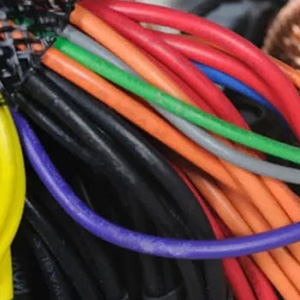 Heat shrink tubing is a versatile material used for insulation, protection, and bundling of wires and other components. The manufacturing process of heat shrink tubing involves several key steps:
Heat shrink tubing is a versatile material used for insulation, protection, and bundling of wires and other components. The manufacturing process of heat shrink tubing involves several key steps:
1. Material Selection
Heat shrink tubing is typically made from polymeric materials such as polyolefin, PVC, fluoropolymers, and elastomers. Polyolefin is the most common material due to its balance of flexibility, strength, and heat shrink properties.
2. Extrusion
The selected polymer is melted and extruded into a tube shape. During extrusion, the polymer is forced through a die to create the desired tube diameter and wall thickness.
3. Cross-Linking
After extrusion, the tubing undergoes a cross-linking process to improve its heat shrink properties and enhance its strength and durability. There are two primary methods of cross-linking:
- Irradiation: The tubing is exposed to high-energy radiation (usually electron beams or gamma rays). This process creates covalent bonds between polymer chains, resulting in a cross-linked structure.
- Chemical Cross-Linking: A chemical agent is added to the polymer, which induces cross-linking when heated.
4. Expansion
Once the tubing is cross-linked, it is expanded to a larger diameter. This is typically done by heating the tubing above its crystalline melting point and then using air pressure or mechanical force to stretch it. The expanded tubing is then cooled rapidly to maintain its expanded shape.
5. Cutting
The expanded tubing is cut into desired lengths. The tubing remains in its expanded form until it is heated during application.
6. Quality Control
Quality control tests are conducted to ensure the tubing meets specific standards and performance criteria. This may include tests for shrink ratio, tensile strength, elongation, dielectric strength, and resistance to various environmental factors.
7. Packaging
The final product is packaged for distribution. Heat shrink tubing is often supplied in spools or pre-cut lengths, depending on customer requirements.
Application
When the heat shrink tubing is applied, it is placed over the object or area to be covered and then heated using a heat gun or other heat source. The heat causes the tubing to shrink back to its original, pre-expanded size, tightly conforming to the shape of the object and providing insulation, protection, and strain relief.
Conclusion
The manufacturing process of heat shrink tubing involves material selection, extrusion, cross-linking, expansion, cutting, quality control, and packaging. The result is a versatile product widely used in electrical, automotive, aerospace, and other industries for its protective and insulating properties.

